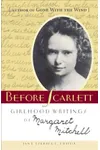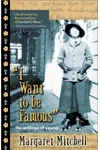Picture a Southern storyteller who spun a tale so grand it swept the world off its feet—meet Margaret Mitchell! Born in Atlanta in 1900, she penned the iconic Gone With the Wind, a Civil War epic that won the Pulitzer Prize and inspired a legendary film. Her vivid characters, like the fiery Scarlett O’Hara and roguish Rhett Butler, still captivate readers today.
Mitchell’s single novel made her a literary legend, but her life was as compelling as her fiction. From her tomboyish childhood to her tragic death in 1949, her journey was one of grit, charm, and an unyielding love for storytelling. Let’s dive into the world of Margaret Mitchell, where history, romance, and drama collide!
The Making of Margaret Mitchell
Margaret Munnerlyn Mitchell grew up in Atlanta, Georgia, surrounded by tales of the Civil War from her family and community. As a precocious child, she wrote plays and stories, often casting herself as the hero. After a brief stint at Smith College, she returned to Atlanta, working as a journalist for the Atlanta Journal. Her sharp wit and keen eye for detail honed her craft, setting the stage for her literary masterpiece.
Marriage to John Marsh in 1925 gave Mitchell stability, but a series of injuries forced her to slow down. Bedridden, she began writing Gone With the Wind, pouring her love for history and complex characters into the novel. What started as a personal project became a cultural phenomenon, proving Mitchell’s storytelling prowess.
Margaret Mitchell’s Unforgettable Stories
Mitchell’s magnum opus, Gone With the Wind, published in 1936, is a sprawling saga of love, loss, and survival during the Civil War and Reconstruction. Scarlett O’Hara, a headstrong Southern belle, navigates a collapsing world with cunning and resilience. Rhett Butler, her roguish counterpart, adds passion and intrigue. The novel’s rich historical detail and emotional depth made it an instant bestseller.
Mitchell’s style blends vivid prose with unflinching realism. She didn’t shy away from flawed characters or the harsh realities of war and societal change. Her themes of survival, identity, and transformation resonate across generations. Though Gone With the Wind remains her only major published novel, Mitchell also wrote short stories and novellas, like Lost Laysen, a romantic tale discovered posthumously in 1996.
Her work reflects the South’s complexities—its beauty, its scars, and its contradictions. Critics praise her storytelling, though some debate the novel’s portrayal of race and history. Regardless, Mitchell’s ability to craft unforgettable characters ensures her work endures.
Why Margaret Mitchell Matters
Margaret Mitchell’s impact transcends her single novel. Gone With the Wind redefined historical fiction, blending romance and grit in a way that inspired countless authors. The 1939 film adaptation, starring Vivien Leigh and Clark Gable, cemented its place in pop culture. Mitchell’s Pulitzer Prize in 1937 and her influence on Southern literature solidify her legacy.
Her work continues to spark discussion about history, gender, and resilience. Readers worldwide connect with Scarlett’s tenacity and Rhe-establishing Mitchell as a voice of enduring power. Tragically, Mitchell died in 1949 after being struck by a car, but her story lives on, as vibrant as the South she loved.
About Margaret Mitchell
- Born: November 8, 1900, in Atlanta, Georgia
- Key Work: Gone With the Wind (1936)
- Award: Pulitzer Prize for Fiction (1937)
- Died: August 16, 1949, after a tragic accident
Ready to lose yourself in a world of passion and perseverance? Grab Gone With the Wind and dive into Margaret Mitchell’s unforgettable Southern saga!






